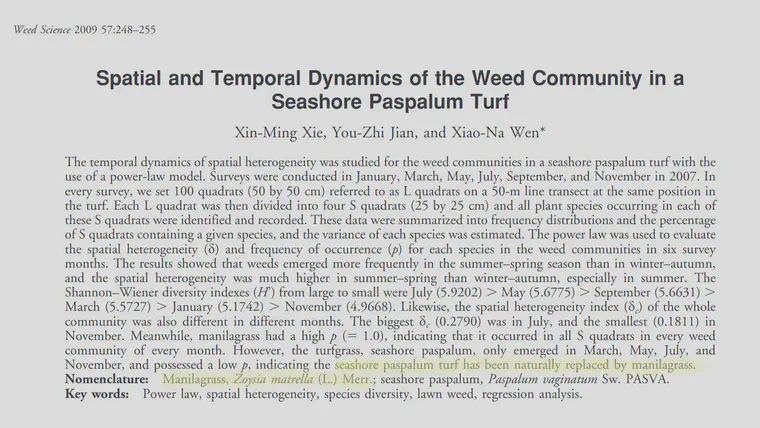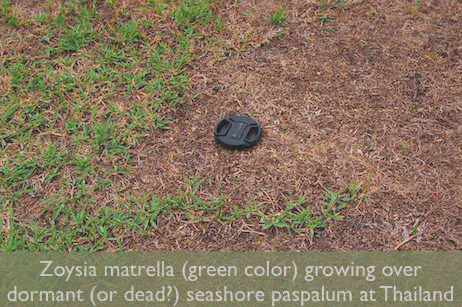Which is a stronger grass, Paspalum or Zoysia?
One of the most interesting articles you can read about seashore paspalum and weeds in the climate of East and Southeast Asia is Spatial and Temporal Dynamics of the Weed Community in a Seashore Paspalum Turf by Xie et al. from South China Agricultural University.

With a title like that, I expected the article to explain what weeds were found in a seashore paspalum turf, where those weeds were, and when those weeds invaded. Were the weeds at the edge of the seashore paspalum area, or were they on a high spot, or in a low area with wet soil, or were the weeds particularly intense in their invasion at certain times of the year? The actual result of this experiment, however, was somewhat unexpected, and is less related to dynamics of a weed community in seashore paspalum than it is to the fitness of seashore paspalum as a turfgrass in Southeast Asia. And this is something that everyone involved in the maintenance of turfgrass in Asia should be aware of.
The experimental results published in Weed Science found that weeds emerged most frequently during the spring and summer at the experimental site at Guangzhou. No surprise there. But what is most surprising is this, and I quote from the researchers in their article: “the seashore paspalum turf has been naturally replaced by manilagrass.” Manilagrass is Zoysia matrella.

The image above shows an area at the ATC research facility that was planted to seashore paspalum and was maintained similar to a golf course fairway for three years, with regular fertilizer and irrigation applications and mowing every two days. During that time of regular maintenance, the paspalum grew fine. But in 2009, when we implemented a reduced maintenance program, with no irrigation and reduced frequency of mowing and reduced fertilization, the ‘Salam’ seashore paspalum went dormant and in some areas was completely overtaken by other grasses, such as the manilagrass as shown above.
Based on what I have seen in Southeast Asia, seashore paspalum must be provided with enough fertilizer and water to maintain a steady growth rate. If the growth of seashore paspalum is allowed to slow, then it will tend to be invaded by bermudagrass, manilagrass, and other weeds. We commonly see this on golf courses, where bermudagrass that has somehow come onto the site will gradually overtake the seashore paspalum. And the research from Weed Science, and our observations at Thailand, show that manilagrass can overtake seashore paspalum as well.
If you are growing seashore paspalum in Southeast Asia, and if you want to keep this grass as the primary species over the long-term, then be vigilant in keeping other grasses out, and by all means maintain a steady growth rate on the seashore paspalum. Use sand topdressing as the primary means to control organic matter buildup and supplement that with coring and verticutting as needed. With extensive inputs, seashore paspalum will perform well in Southeast Asia. Without intensive maintenance, however, seashore paspalum does not persist and will be overgrown by bermudagrass, manilagrass, or other plants more suited to this growing environment.